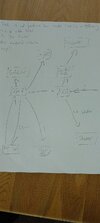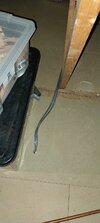Bathroom installation
Not DIY
RCD(loft) Fed from light circuit (1 or 1.5mm not sure).
I can't remember if before this work there was a loop in/out or if this was the end of the circuit .
Shaver socket fed from RCD, no fused connector for the shaver socket
Digital shower fed via fsu from RCD
3 pole isolator 2 (loft) fed from RCD, currently in off position, nothing is off. Yes the isolator is inoperative and being used only as a junction box. Hopefully nobody working on the extractor assumes the isolator would, you know, isolate.
Extractor fed by isolator 2, but not since it doesn't isolate.
3 pole pull cord isolator in room (we asked the sparky who fitted the old extractor to put one in the room so we could switch off over night, it was previously in series with isolator 1 when isolator 1 actually isolated). Pull cord isolator is fed from isolator 1.
Cable for isolator 2 now comes up from middle of loft floor, trip/snag hazard.
Lights fed from isolator 2 , not isolated by pull isolator 1.
The question marks are where I made assumptions because I couldn't follow the cable
Anything I missed?
Ta
Not DIY
RCD(loft) Fed from light circuit (1 or 1.5mm not sure).
I can't remember if before this work there was a loop in/out or if this was the end of the circuit .
Shaver socket fed from RCD, no fused connector for the shaver socket
Digital shower fed via fsu from RCD
3 pole isolator 2 (loft) fed from RCD, currently in off position, nothing is off. Yes the isolator is inoperative and being used only as a junction box. Hopefully nobody working on the extractor assumes the isolator would, you know, isolate.
Extractor fed by isolator 2, but not since it doesn't isolate.
3 pole pull cord isolator in room (we asked the sparky who fitted the old extractor to put one in the room so we could switch off over night, it was previously in series with isolator 1 when isolator 1 actually isolated). Pull cord isolator is fed from isolator 1.
Cable for isolator 2 now comes up from middle of loft floor, trip/snag hazard.
Lights fed from isolator 2 , not isolated by pull isolator 1.
The question marks are where I made assumptions because I couldn't follow the cable
Anything I missed?
Ta
Attachments
Last edited:



